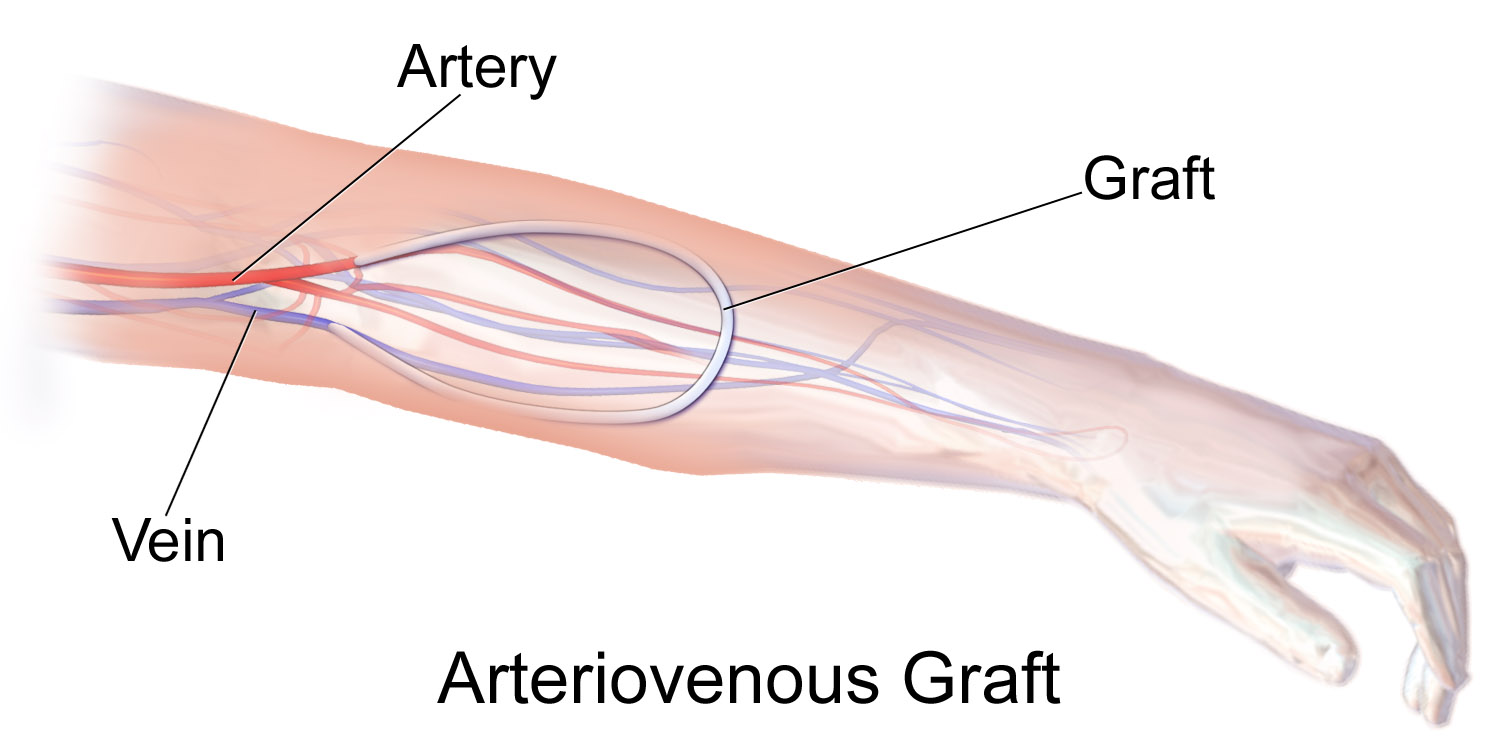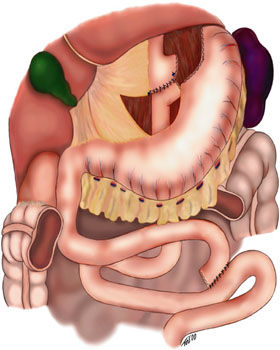|
Bypass Surgery
Bypass surgery refers to a class of surgery involving rerouting a tubular body part. Types include: * Vascular bypass surgery such as coronary artery bypass surgery, a heart operation * Cardiopulmonary bypass, a technique used in coronary artery bypass surgery * Weight loss or Bariatric surgery: ** Vertical banded gastroplasty surgery or "stomach stapling", the upper part of the stomach is permanently stapled to create a smaller pouch ** Adjustable gastric band or "lap band", a band creates a pocket in the stomach that can be adjusted with a port placed just under the skin ** Roux-en-Y gastric bypass surgery, the small intestine is connected to the upper part of the stomach ** Partial ileal bypass surgery, shortening the final portion of the small intestine ** Popliteal bypass surgery, to treat diseased leg arteries above or below the knee ** Jejunojejunostomy, surgery that connects two portions of small intestine and is no longer used *** Ileojejunal bypass The ileojejunal bypas ... [...More Info...] [...Related Items...] OR: [Wikipedia] [Google] [Baidu] |
Vascular Bypass
A vascular bypass is a surgical procedure performed to redirect blood flow from one area to another by reconnecting blood vessels. Often, this is done to bypass around a diseased artery, from an area of normal blood flow to another relatively normal area. It is commonly performed due to inadequate blood flow (ischemia) caused by atherosclerosis, as a part of organ transplantation, or for vascular access in hemodialysis. In general, someone's own vein (autograft) is the preferred graft material (or conduit) for a vascular bypass, but other types of grafts such as polytetrafluoroethylene (Teflon), polyethylene terephthalate (Dacron), or a different person's vein (allograft) are also commonly used. Arteries can also serve as vascular grafts. A surgeon sews the graft to the source and target vessels by hand using surgical suture, creating a surgical anastomosis. Common bypass sites include the heart (coronary artery bypass surgery) to treat coronary artery disease, and the legs, where ... [...More Info...] [...Related Items...] OR: [Wikipedia] [Google] [Baidu] |
Coronary Artery Bypass Surgery
Coronary artery bypass surgery, also known as coronary artery bypass graft (CABG, pronounced "cabbage") is a surgical procedure to treat coronary artery disease (CAD), the buildup of plaques in the arteries of the heart. It can relieve chest pain caused by CAD, slow the progression of CAD, and increase life expectancy. It aims to bypass narrowings in heart arteries by using arteries or veins harvested from other parts of the body, thus restoring adequate blood supply to the previously ischemic (deprived of blood) heart. There are two main approaches. The first uses a cardiopulmonary bypass machine, a machine which takes over the functions of the heart and lungs during surgery by circulating blood and oxygen. With the heart in arrest, harvested arteries and veins are used to connect across problematic regions—a construction known as surgical anastomosis. In the second approach, called the off-pump coronary artery bypass graft (OPCABG), these anastomoses are constructed while t ... [...More Info...] [...Related Items...] OR: [Wikipedia] [Google] [Baidu] |
Cardiopulmonary Bypass
Cardiopulmonary bypass (CPB) is a technique in which a machine temporarily takes over the function of the heart and lungs during surgery, maintaining the circulation of blood and oxygen to the body. The CPB pump itself is often referred to as a heart–lung machine or "the pump". Cardiopulmonary bypass pumps are operated by perfusionists. CPB is a form of extracorporeal circulation. Extracorporeal membrane oxygenation is generally used for longer-term treatment. CPB mechanically circulates and oxygenates blood for the body while bypassing the heart and lungs. It uses a heart–lung machine to maintain perfusion to other body organs and tissues while the surgeon works in a bloodless surgical field. The surgeon places a cannula in the right atrium, vena cava, or femoral vein to withdraw blood from the body. Venous blood is removed from the body by the cannula and then filtered, cooled or warmed, and oxygenated before it is returned to the body by a mechanical pump. The cannula used ... [...More Info...] [...Related Items...] OR: [Wikipedia] [Google] [Baidu] |
Bariatric Surgery
Bariatric surgery (or weight loss surgery) includes a variety of procedures performed on people who are obese. Long term weight loss through the standard of care procedures ( Roux en-Y bypass, sleeve gastrectomy, and biliopancreatic diversion with duodenal switch) is largely achieved by altering gut hormone levels responsible for hunger and satiety, leading to a new hormonal weight set point. Bariatric surgery is the most effective treatment causing weight loss and reducing complications of obesity. As of October 2022, the American Society of Metabolic and Bariatric Surgery (ASMBS) and International Federation for the Surgery of Obesity (IFSO) recommend bariatric surgery for adults with a body mass index (BMI) >35, regardless of obesity-associated conditions, and recommend considering surgery for people with BMI 30.0-34.9 who have metabolic disease. This is a recent change in guidelines (October 2022), so other guideline-producing organizations and health insurance plans may t ... [...More Info...] [...Related Items...] OR: [Wikipedia] [Google] [Baidu] |
Vertical Banded Gastroplasty Surgery
Vertical banded gastroplasty (VBG), also known as stomach stapling, is a form of bariatric surgery for weight control. The VBG procedure involves using a band and staples to create a small stomach pouch. In the bottom of the pouch is an approximate one-centimeter hole through which the pouch contents can flow into the remainder of the stomach and hence on to the remainder of the gastrointestinal tract. Stomach stapling is a restrictive technique for managing obesity. The pouch limits the amount of food a patient can eat at one time and slows passage of the food. Stomach stapling is more effective when combined with a malabsorptive technique, in which part of the digestive tract is bypassed, reducing the absorption of calories and nutrients. Combined restrictive and malabsorptive techniques are called gastric bypass techniques, of which Roux-en-Y gastric bypass surgery (RGB) is the most common. In this technique, staples are used to form a pouch that is connected to the small int ... [...More Info...] [...Related Items...] OR: [Wikipedia] [Google] [Baidu] |
Adjustable Gastric Band
A laparoscopic adjustable gastric band, commonly called a lap-band, A band, or LAGB, is an inflatable silicone device placed around the top portion of the stomach to treat obesity, intended to decrease food consumption. Adjustable gastric band surgery is an example of bariatric surgery designed for obese patients with a body mass index (BMI) of 40 or greater—or between 35 and 40 in cases of patients with certain Comorbidity, comorbidities that are known to improve with weight loss, such as sleep apnea, diabetes, osteoarthritis, GERD, Hypertension, hypertension (high blood pressure), or metabolic syndrome, among others. In February 2011, the United States Food and Drug Administration (FDA) expanded approval of adjustable gastric bands to patients with a BMI between 30 and 40 and one weight-related medical condition, such as diabetes or high blood pressure. However, an adjustable gastric band may be used only after other methods such as diet and exercise have been tried. Working ... [...More Info...] [...Related Items...] OR: [Wikipedia] [Google] [Baidu] |
Roux-en-Y Gastric Bypass Surgery
Gastric bypass surgery refers to a technique in which the stomach is divided into a small upper pouch and a much larger lower "remnant" pouch and then the small intestine is rearranged to connect to both. Surgeons have developed several different ways to reconnect the intestine, thus leading to several different gastric bypass procedures (GBP). Any GBP leads to a marked reduction in the functional volume of the stomach, accompanied by an altered physiological and physical response to food. The operation is prescribed to treat morbid obesity (defined as a body mass index greater than 40), type 2 diabetes, hypertension, sleep apnea, and other comorbid conditions. ''Bariatric surgery'' is the term encompassing ''all'' of the surgical treatments for morbid obesity, not just gastric bypasses, which make up only one class of such operations. The resulting weight loss, typically dramatic, markedly reduces comorbidities. The long-term mortality rate of gastric bypass patients has been ... [...More Info...] [...Related Items...] OR: [Wikipedia] [Google] [Baidu] |
Partial Ileal Bypass Surgery
Partial ileal bypass surgery is a surgical procedure which involves shortening the ileum to shorten the total small intestinal length. First introduced in 1962 by Professor Henry Buchwald of the University of Minnesota, the procedure is used to treat a number of hyperlipidemias including familial hypercholesterolemia. The only randomized controlled trial comparing bypass surgery with standard management was the POSCH trial, which was conducted by Buchwald and his team. The trial ran between 1975 and 1983 and included 838 men who had survived a heart attack. This trial initially failed to show any benefit on mortality, but in 1998 follow-up results indicated that in addition to its known benefit on cholesterol levels and disease events it had also decreased mortality in the treatment group. Ileal bypass surgery was mainly performed prior to the introduction of effective oral medication for the most common hypercholesterolemias. It is occasionally used in the surgical treatment of o ... [...More Info...] [...Related Items...] OR: [Wikipedia] [Google] [Baidu] |
Popliteal Bypass Surgery
Popliteal bypass surgery, more commonly known as femoropopliteal bypass (FPB, fem-pop, etc.) or more generally as lower extremity bypass surgery, is a surgical procedure used to treat diseased leg arteries above or below the knee. It is used as a medical intervention to salvage limbs that are at risk of amputation and to improve walking ability in people with severe intermittent claudication (leg muscle pain) and ischemic rest pain. Popliteal bypass surgery is a common type of peripheral bypass surgery which carries blood from the femoral artery of the thigh to the end of the popliteal artery behind the knee. The femoral artery runs along the thigh and extends to become the popliteal artery which runs posteriorly to the knee and femur. Smaller arteries carry blood supply from the popliteal artery to the calf and into the foot. Blockages caused by plaque build-up or atherosclerosis in any of these arteries can reduce leg blood circulation, causing leg pain that may interfere with d ... [...More Info...] [...Related Items...] OR: [Wikipedia] [Google] [Baidu] |
Jejunojejunostomy
Jejunojejunostomy is a surgical technique used in an anastomosis between two portions of the jejunum. It is a type of bypass occurring in the intestine. It may lead to marked reduction in the functional volume of the intestine. This technique is also performed using Laparoscopic surgery. The surgical procedure can lead to complications including infections, hemorrhage, strictures, ulcers, intestinal obstruction, thromboembolism and malnutrition Malnutrition occurs when an organism gets too few or too many nutrients, resulting in health problems. Specifically, it is "a deficiency, excess, or imbalance of energy, protein and other nutrients" which adversely affects the body's tissues a .... References Digestive system surgery {{Surgery-stub ... [...More Info...] [...Related Items...] OR: [Wikipedia] [Google] [Baidu] |
Ileojejunal Bypass
The ileojejunal bypass is an experimental surgery designed as a remedy for morbid obesity. It was first performed on a series of patients at White Memorial Hospital, Los Angeles, California Los Angeles ( ; es, Los Ángeles, link=no , ), often referred to by its initials L.A., is the largest city in the state of California and the second most populous city in the United States after New York City, as well as one of the world' ..., in the mid- to late-1970s. References General surgery {{Surgery-stub ... [...More Info...] [...Related Items...] OR: [Wikipedia] [Google] [Baidu] |





